A quarter-century ago, electrical engineer James Chang (
After a couple of years, not only had Chang's unusual virtuoso persistence paid off and the woman agreed to marry him, but he'd also discovered that he had developed quite a passion for the stringed instrument. It remained, however, purely a hobby, as much of Chang's time was spent working at his micro and subminiature lamp company.
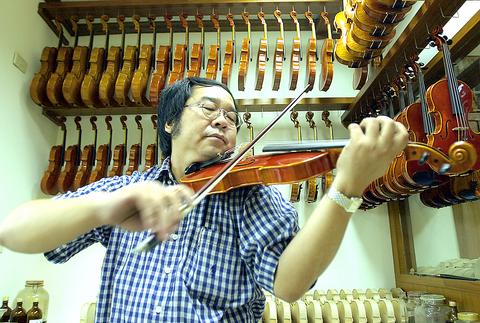
Twenty-five years and two children later, Chang, still toying with and collecting violins, decided that he'd had enough of paying for expensive European instruments and had become enraged by what he describes as "the awful sound" of cheap sub-standard Chinese copies.
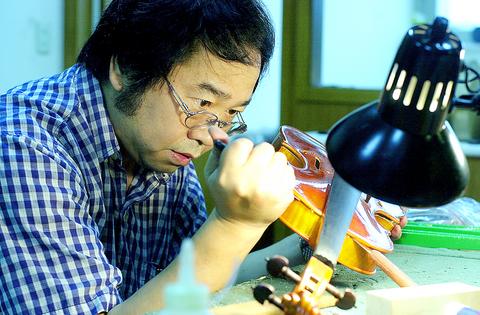
PHOTOS: CHEN CHENG-CHANG, TAIPEI TIMES
"While I only ever played as a hobby, both my daughters take the violin very seriously. Because of that I've spent a lot of money trying to find an instrument that looked and sounded good," Chang said. "The problem was always one of cost over quality. I'd purchase a cheap one and the sound would be awful, or I'd pay upwards of NT$40,000 and realize that I was spending too much money. So I decided to make my own."
After telling Italian-trained violin maker Chiao Chung-hsing (焦中興) of his wish to produce top-quality violins in 1995, Chang discovered he had an ally and was soon studying the intricacies of high-quality violins under Chiao's guidance. Learning to master the craft, however, proved to be a time-consuming process and it took Chang almost a year to complete his first violin.
Shortly thereafter, Chang took the unusual step of converting a vacant office adjacent to his lamp company in the sprawling suburb of Hsichih into a workshop. Filling the workshop with violin-manufacturing equipment purchased in Germany, and with the help of his teacher, the enterprising Chang set about honing both his violin design and assembly techniques.
In less than a year he had built up enough confidence in his ability to create the near-perfect violin that, on the advice of his teacher, he packed his bags and flew to the US to participate in an international violin manufacturing competition organized by The Violin Society of America. However, Chang would soon wish he'd never heard of the competition, let alone enter it.
"It was a good insight into how people presumed that any instrument not made in Europe was substandard. But it certainly wasn't a memory I cherish," Chang recalled. "The judges dismissed my violin as below par simply because it was made in Taiwan. They didn't even play it to check the sound. It was pretty unfair and very biased. All the top prizes went to European manufacturers." Bloodied but unbowed after his sobering experience in the US, Chang returned to Taiwan even more intent on proving that Taiwan wasn't simply a nation that produced high-tech electrical components and plastic Christmas kitsch.
Purchasing a rundown factory in Shanghai three years ago, Chang and his teacher planned to instruct the employees on high-quality violin manufacturing. A business disagreement related to how best to achieve this, however, saw Chang parting company with his mentor shortly after production began.
"We had differing ideas as to how the factory should be run. He wanted this and I wanted that and so on, which was a pity, but such things happen in business," Chang said. "We're still friends, though. And he remains someone I both respect and with whom I can chat about violin design."
While the rift meant that Chang -- who still considers himself a novice violin maker -- was forced to go it alone in Shanghai, the factory prospered nonetheless. It now has 40 full-time staff who turn out scores of handmade violins, cellos and double bass bodies per month. The factory's primary product, however, remains the violin, with roughly 200 of the instruments produced on a monthly basis.
The unvarnished and unassembled bodies are still shipped to Chang's workshop in Hsihchih for finishing. According to the musical entrepreneur, it would not only prove too costly to train factory staff to assemble and finish the instruments, but he felt that quality control would have been lost and his cherished product become simply another sub-standard violin in a market already swamped by such products.
"I wouldn't want my violins to end up with a bad reputation like others made in China. Finishing violins is a tricky process. There are many different varnishes, each of which needs to be applied in certain ways," he continued. "I personally varnish all the unfinished bodies that come from the factory in China, as I feel such personal treatment makes each one unique."
With such large numbers of hand-crafted violin bodies coming off the Shanghai production line, Chang decided to open his own music conservatory. Called the Golden Violin School of Music, the private school has come to the attention of some of Taiwan's leading violinists including Lin Chao-liang (林昭亮), an internationally renowned violinist, who records for the popular Sony Classical label.
"I've donated several of my instruments to well known musicians and ensembles and both the school and workshop have received favorable comments from some highly respected people, including Lin Chao-liang," Chang said. "But my real aim is to supply all the nation's ensembles and orchestras with Taiwan-made violins."
Chang's school, while already the venue for recitals and seminars, has yet to officially open for business and is currently waiting for ISO accreditation. According to Chang, this should pave the way for a new generation of local fiddlers to prove to the world that Taiwan has both the engineering know-how and talent to produce world-class violinists who use home-made, quality products which Chang prices at roughly NT$18,000 per piece.
"Obviously to realize my dream I need to start somewhere, and what better place to start than with the young," Chang said. "If I can prove that my violins are of European quality but with a price tag that is Asian, then I reckon school orchestras will be interested in using my violins rather than Chinese ones."
In the meantime, Chang continues to develop his violin designs as well as educate. There is little chance of Chang combining his electronics expertise with his violin-designing prowess, however.
"There's no way I'd ever design an electric violin," said a grimacing Chang. "That just wouldn't be the appropriate thing to do with such a beautiful and pure instrument."
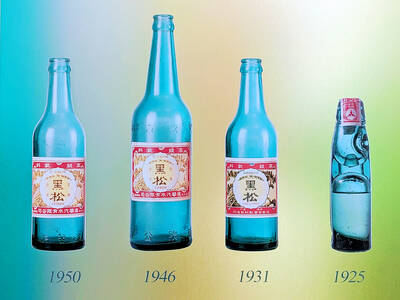
Aug. 4 to Aug. 10 When Coca-Cola finally pushed its way into Taiwan’s market in 1968, it allegedly vowed to wipe out its major domestic rival Hey Song within five years. But Hey Song, which began as a manual operation in a family cow shed in 1925, had proven its resilience, surviving numerous setbacks — including the loss of autonomy and nearly all its assets due to the Japanese colonial government’s wartime economic policy. By the 1960s, Hey Song had risen to the top of Taiwan’s beverage industry. This success was driven not only by president Chang Wen-chi’s
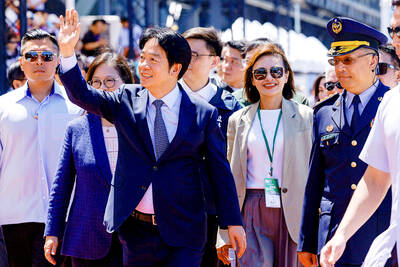
Last week, on the heels of the recall election that turned out so badly for Taiwan, came the news that US President Donald Trump had blocked the transit of President William Lai (賴清德) through the US on his way to Latin America. A few days later the international media reported that in June a scheduled visit by Minister of National Defense Wellington Koo (顧立雄) for high level meetings was canceled by the US after China’s President Xi Jinping (習近平) asked Trump to curb US engagement with Taiwan during a June phone call. The cancellation of Lai’s transit was a gaudy
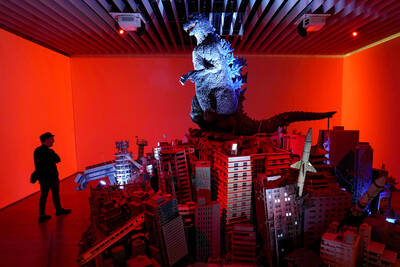
From Godzilla’s fiery atomic breath to post-apocalyptic anime and harrowing depictions of radiation sickness, the influence of the nuclear bombings of Hiroshima and Nagasaki runs deep in Japanese popular culture. In the 80 years since the World War II attacks, stories of destruction and mutation have been fused with fears around natural disasters and, more recently, the Fukushima crisis. Classic manga and anime series Astro Boy is called “Mighty Atom” in Japanese, while city-leveling explosions loom large in other titles such as Akira, Neon Genesis Evangelion and Attack on Titan. “Living through tremendous pain” and overcoming trauma is a recurrent theme in Japan’s
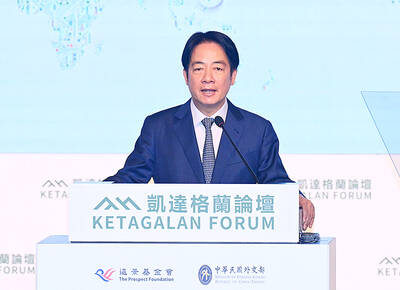
As last month dawned, the Democratic Progressive Party (DPP) was in a good position. The recall campaigns had strong momentum, polling showed many Chinese Nationalist Party (KMT) lawmakers at risk of recall and even the KMT was bracing for losing seats while facing a tsunami of voter fraud investigations. Polling pointed to some of the recalls being a lock for victory. Though in most districts the majority was against recalling their lawmaker, among voters “definitely” planning to vote, there were double-digit margins in favor of recall in at least five districts, with three districts near or above 20 percent in